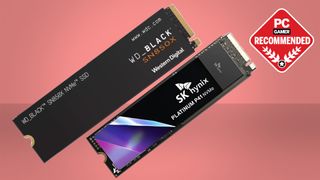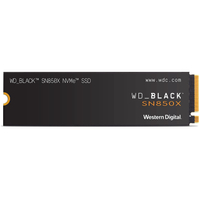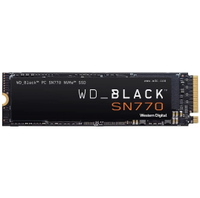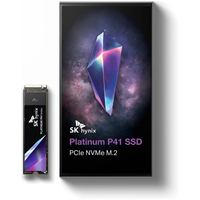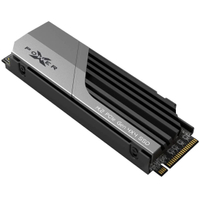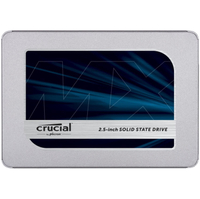Your PC deserves the best SSD for gaming. A faster SSD means quicker file transfers and game texture loading, while a larger one allows you to keep all your gameplay highlights without deleting them to make space for new games. The impact of good storage on your PC gaming experience cannot be overstated.
Microsoft's DirectStorage takes full advantage of cutting-edge PCIe 4.0 and PCIe 5.0 drives. Even though support may be limited to just one game at the moment, the best SSDs for gaming are versatile and offer many benefits beyond gaming. The WD Black SN850X is a standout choice, our top pick for gaming SSDs. It not only performs flawlessly and efficiently during gaming sessions but also excels in handling larger file transfers, making it ideal for video editing tasks as well.
Of course, any SSD will represent a massive improvement over a traditional hard drive. Each drive on this list has undergone extensive benchmarking, combining real-world game loading tests with synthetic speed evaluations to identify the ultimate SSDs for gaming. I used each SSDs as the primary drive in a new Windows 11 installation to verify their performance.
Our recommended SSDs generally start at 1TB as a minimum. Smaller drives might be more budget-friendly but suffer a noticeable drop in speed. With today's games taking up so much space, a 250GB SSD won't cut it anymore. While 2TB and 4TB SSDs may be pricey, if you come across a sale, don't hesitate to seize the opportunity for maximum storage capacity. Your gaming experience will thank you for it.
Where are the best SSD deals?
In the US:
- Amazon - Up to 50% off internal and external SSDs
- Walmart - Deals on internal and external SSDs
- B&H Photo - Save up to $50 on NVMe SSDs
- Best Buy - Great prices on Samsung SSDs
- Staples - Save up to 30% on a range of SSDs, USB sticks, and external SSDs
- Newegg - Plenty of NVMe SSDs
In the UK:
- Amazon UK - Save on HDDs, SDDs, and external drives
- Scan - SATA drives as low as £21
- Box - Save up to £82 on Western Digital SN750 NVMe SSDs
- Ebuyer - 500GB SSDs starting from £34.98
- Overclockers - Save up to £51 on Samsung SSDs
- Currys - Save £33.00 on WD Black SN750
- Laptops Direct - Save on SSDs for your laptop
Best SSD for gaming
PC Gamer's got your back Our experienced team dedicates many hours to every review, to really get to the heart of what matters most to you. Find out more about how we evaluate games and hardware.

Our favorite WD Black SN850X config:
The arrival of the Ryzen Zen 4 CPU family means that PCIe Gen 5 is now a thing on both AMD and Intel platforms. But let’s be real. Your current PC almost certainly doesn’t have a PCIe 5.0 M.2 slot. Enter, therefore, the new WD Black SN850X, something of a last hurrah for Gen 4 SSDs. And it's the best one out there right now.
SK Hynix's Platinum P41 might just have the edge on performance, but the lead is so negligible that the less expensive SN850X is our pick of the current SSD crop.
Our review configuration is clad head-to-toe in WD’s signature armour-style cooling, but it needn't have bothered. This SSD runs quite a bit cooler than even its forebear, the WD Black SN850.
In many other regards, this new X model is a dead ringer for the existing SN850. We’re talking four lanes of PCIe Gen 4 connectivity in the now ubiquitous M.2 2280 form factor. But the 1TB model reviewed here is now the entry-level option. There’s no longer a 512GB model. What’s more, WD’s in-house controller chip, provided by compatriot SanDisk, has been revised, though detailed specifics aren't provided.
It improves game loading times courtesy of a so-called "read look-ahead" algorithm, which predictively caches game data.
Rather more specific to this WD drive is the latest 2.0 version of the company’s Game Mode drive management software. WD claims it improves game loading times courtesy of a so-called "read look-ahead" algorithm, which predictively caches game data. It now runs automatically, detecting when games are loaded. How much that kind of feature actually makes a difference in the real world is notoriously difficult to pin down. But it’s unlikely to be revolutionary.
Reduced operating temps are another clear benefit of this new drive. The old SN850 hit a toasty 77°C. The new drive hits just 58°C under sustained load. That's a very worthwhile improvement. Elsewhere, the gains are less obvious, albeit the SN850 was already a great drive. The 4K random access results are a little disappointing, showing little to no improvement. Likewise, don’t expect big gains in system-wide measures of performance like PC Mark 10.
All of which means that the new WD Black SN850X isn't exactly a revolutionary leap forward. Indeed, in the real world, you’ll struggle to notice the difference compared to the existing SN850 drive. But then that's because the SN850 is a very good SSD. The one exception to that is operating temperatures. Happily, this new X model runs unambiguously cooler.
For most PC applications, that probably doesn’t matter. But for small form factor rigs and perhaps a gaming laptop, every little can certainly help. On that note, for most applications, we'd probably go for the cheaper bare drive rather than this more expensive model with its heat spreader. The revised SN850X is inherently a cooler-running thing, after all.
Read our full WD Black SN850X SSD review.

Our favorite WD Black SN770 config:
We've seen some incredible NVMe SSD releases recently, but they've tended to focus on top-end performance and come with prices to match. The WD_Black SN770 bucks this trend and, like its predecessor, the SN750, is aimed at offering better value for money than outright performance.
The main way it achieves this is by being a DRAM-less SSD drive. This saves a big chunk of the manufacturer's bill of materials, and thanks to advances in the latest controllers, it can be surprising how little impact this has on performance. Such drives are slower, don't get me wrong, but this new SN770 still quotes read and writes of 5,150MB/s and 4,900MB/s, respectively. Not bad.
The drive is a low-profile affair, with this 1TB model boasting a single NAND flash module at the back (a rebranded Kioxia BiCS5 112-Layer TLC chip) and the SanDisk controller towards the connector. Western Digital rarely reveals much about its controllers, which is the case here.
The SN770 is available in four sizes—250GB, 500GB, 1TB, and 2TB, although there's no 4TB option, which is a bit of a shame. If you want a seriously capacious drive, you'll want to track down the Sabrent Rocket offerings, which go all the way up to 8TB.
It's in the real-world tests where the SN770 really struts its stuff.
The synthetic performance shows the SN770 trails more expensive drives in terms of reads, although the writes are much closer. The 4K performance is relatively impressive and shows that the SN770 has something to offer in this crowded marketplace. It's not too surprising that this drive outperforms Samsung's DRAM-less offering, as that is a PCIe 3.0 drive, after all, but the extent to which it does is impressive.
It's worth noting that this drive can get hot when pushed, just like the SN850. It hit 76°C after a long day of testing, but without direct cooling on it, not even a heatsink. It should be fine in most systems, especially if your motherboard does come with some cooling solution.
It's in the real-world tests where the SN770 really struts its stuff. You'd be hard-pushed to tell the difference between this drive and much faster offerings in most day-to-day operations. Given this is the cheaper drive right now, that counts for a lot. The SN850 is the better drive if you need better performance, but you will pay considerably more.
The only problem for this drive is that we don't know how fast a drive needs to be for Microsoft's DirectStorage. We know some developers have been targeting 5,000MB/s, which is where the SN770 sits in our testing. So it should be good, and it's very tempting for the money. If you're a serious gamer, though, we'd recommend going a little bit higher up the product stack, and grabbing that WD_Black SN850.
Read our full WD Black SN770 1TB review.

Our favorite SK Hynix Platinum P41 config:
Give it up for the new SK Hynix Platinum P41 2TB. If that doesn't exactly roll off the tongue, it also doesn't help that SK Hynix isn't the most familiar brand when it comes to the sort of consumer-focussed clobber that's aimed at gamers, including SSDs.
SK Hynix, of course, isn't actually new to this space, but the new P41 is arguably the brand's first tilt at a truly high-end M.2 drive. The old SK Hynix Gold P31 was a bit of a clunky old thing, limited as it was to the PCIe 3.0 interface and a controller chip with a mere four memory channels. The new Platinum P41? It's got it all.
Well, it's got it all if the context is PCIe 4.0 drives. The PCIe Gen 5 revolution is just around the corner. But for now, PCIe Gen 4 is not only where it's at. It's probably also the limit of your PC or laptop's capabilities. Anyway, the P41 has SK Hynix's brand new Gen 4 controller, known as Aries. While these things tend to be relatively mysterious black boxes, we do at least know that Aries has a claimed doubling of IOPS performance versus SK Hynix's old Cepheues chip, along with one-third faster IO speeds.
Not only that, it's also a quad-core design that sports eight memory controllers and allocates 2GB of DDR4 cache memory for this 2TB model. All of which makes it on par with top-end controllers like the Phison E18, as seen in various drives including the Seagate FireCuda 530, the SanDisk-powered WD Black SN850X, and the new Pascal chip in the Samsung 990 Pro.
The Platinum P41 is basically as fast as anything else out there.
As for the actual flash memory used, it's SK Hynix's latest and very greatest 176-layer 3D TLC NAND. It's about as advanced as TLC memory currently gets, and SK Hynix claims a 40% performance boost over its old 128-layer chips. The net result is sequential read and write specs for this 2TB model of 7,000MB/s and 6,500MB/s respectively.
Finally, on the speeds and feeds, this 2TB drive is rated at 1,200TB for write endurance. As it happens, that's exactly the same as the new Samsung 990 Pro 2TB. But it's also a fair distance short of some other competing M.2 SSDs.
All of which just leaves the minor matter of how this drive actually performs. When it comes to peak sequential throughput, the Platinum P41 is basically as fast as anything else out there, bar a few rounding errors. OK, the Samsung 990 Pro is a bit faster at 7,462MB/s for reads to the P41's 7,375MB/s. But, honestly, it's inconsequential. The same goes for writes, where pretty much all the top drives will do just under 6.9GB/s.
Slightly less edifying are the P41's operating temps. At 71°C peak, it's a little toastier than we'd ideally like. Not that we actually saw any signs of any thermal throttling. But temps that high are a teensy bit of a long-term reliability concern.
So, this is a damn good drive. It's at least as good as anything else: trading blows with WD's Black SN850X, Samsung's upgraded 990 Pro, and the usual Phison E18-powered suspects. If you want a top-end PCIe 4.0 drive, there's certainly plenty of choices. And the SK Hynix Platinum P41 2TB should certainly be on your shortlist.
Read our full SK Hynix Platinum P41 review.
Our favorite Sabrent Rocket 2230 config:
Praise be to the good lord Gabe, more NVMe drives in the Steam Deck's puny 2230 form factor have started to drop. Now is the time for tinkering, and the voiding of warranties. And if you're sitting there asking yourself "Is a Steam Deck SSD upgrade worth it?" I'm going to lay it out for you.
I've been through and tested each of Sabrent's new collection of Rocket NVMe 2230 SSDs, pitting each one against the Steam Deck's own, internal NVMe drive to see if upgrading the Steam Deck SSD will make a tangible improvement to your handheld experience. Or just hold you back.
So we're on the same page, you may have a different SSD in your Deck than mine. That's because Valve downgraded the steam decks internal SSD in some cases, so it's a bit of a lottery whether 256GB and 512GB models will come with a PCIe Gen 3x4 or Gen 3x2 SSD. I'm testing against my Deck's Gen 3x4 512GB (ESMP512GKB4C3-E13TS) SSD, with a Phison controller and 96-Layer TLC Flash memory.
There doesn't seem to be a trade-off in terms of performance and power draw—that's a win/win!
Coming in 256GB, 512GB, and 1TB capacities, Sabrent's diddy Gen 4x4 drives retail at $50, $90, and $170 respectively. That's substantially more than you'd expect to pay for a similar capacity 2280 form-factor drive but sure, I'll bite. Not like there's much tiny, high speed competition out there at the moment.
The 256GB is rated to 4,640MB/s reads and 1,900MB/s writes, whereas the 512GB is meant to be closer to 5,000MB/s reads, and 3,700MB/s writes. The 1TB drops down a little at 4,750MB/s reads, but 4,300MB/s write speeds. And with each featuring 177-layer 3D NAND flash tech, we should see some real tangible improvements over the Steam Decks internal SSD, however many lanes Valve has seen fit to grace your Steam Deck with. Whether that's going to translate to real-world performance—and whether it has the potential to tank the Deck's battery—is another matter.
My Deck's original Phison SSD chugs along with read/write speeds of 2,292MB/s and 1,176MB/s. Random 4K reads sit at 54MB/s and 235MB/s writes. The random performance is where Steam Deck users should be looking, as it simulates the kind of real-world, intermittent accessing the drive will undergo on a daily basis.
Jamming the like-for-like capacity Sabrent Rocket 512GB SSD in the Steam Deck saw an average power draw of more like 2W which, considering the difference in KdiskMark scores is really something. I'd expected a much higher power draw with read/write speeds closer to 3,566MB/s and 2,853MB/s, but considering games that previously took 20 seconds to load up a new game were now revving up in under 14 seconds, and 30 second loads had been sliced by a good 11 seconds, it's not like the SSD had much time to rev up even if the power draw had increased.
In other words, there doesn't seem to be a trade-off in terms of performance and power draw—that's a win/win!
When it comes to real-world random performance, the 512GB Sabrent rocks a good 78MB/s read speed over the Phison, with 252MB/s writes to boot. That means my 7GB file transfer time has decreased pretty substantially, from 36 seconds down to 14.
For those currently packing the lower capacity Steam Decks bagging the 512GB Sabrent drive is a no brainer. Particularly when you consider their combined price is $160 less than the 512GB Deck. Even the 256GB option is a stellar choice if you're looking to save $30 on something just as speedy as its 512GB sibling. If you can forgo a bit of storage space, it'll certainly blow whatever eMMC SSD the 64GB Deck's touting out of the water.
Read our full Sabrent Rocket 2230 review.

Our favorite Silicon Power XS70 SSD config:
Silicon Power is a brand that probably doesn’t get much attention compared to the likes of Samsung or WD, but when you look at its latest XS70 NVMe SSD with its high-end specifications, it's clear that the brand name isn't everything. Armed with the latest Phison controller and high-performance NAND flash memory, a drive like the Silicon Power XS70 should have no problem competing with the best SSD on the market.
At $170, the XS70 is priced well for a high-performance 2TB SSD, but there's fierce competition from other third-party SSD makers in this price range. The Silicon Power XS70 2TB SSD is a 2280 (80mm length) M.2 PCIe NVMe drive. It combines Micron 176-Layer TLC NAND with a Phison PS5018-E18 controller and 2GB of DDR4 RAM. That combination is common to many of the best SSDs, including the highly regarded Seagate FireCuda 530 and Kingston KC3000.
It's a highly competitive SSD with great performance and an attractive design and offers good value for money.
The XS70 is designed with PS5 compatibility in mind so the heatsink isn’t as bulky as some others you might come across. It really does look good. Admittedly I'm talking about an SSD here, and its not the kind of thing you'll spend time looking at, but Silicon Power's designers deserve credit.
The Silicon Power XS70 2TB isn't revolutionary, but then nobody expects it to be. It's a highly competitive SSD with great performance, an attractive design and it offers good value for money. It's not perfect, it lacks its own software and hardware encryption but for a PS5 or PC gamer, that won't matter. Load it up with your game library and you'll love it.
The excellent all-around performance on offer from the XS70 makes it a very compelling option and it's easily worth considering if it’s price competitive at the time you look to make your purchase.
Read our full Silicon Power 2TB XS70 review.

Our favorite Crucial MX500 config:
The Crucial MX500 is the only SATA drive left on our list of the best SSDs for gaming. When the price delta between PCIe and SATA is so small, it's difficult to make an argument for the far slower technology. But, as there is a hard limit on the number of M.2 slots on your motherboard, there is still a place for SATA SSDs as secondary storage.
And the Crucial MX500 is one of the best. With SATA's maximum theoretical bandwidth limit of 600MB/s, it's nearly as quick as you'll get, and Crucial's drives have long been among the best-value options available too. This is the most affordable 1TB SATA drive you can pick up and it makes a great second home for your Steam and Epic libraries.
It will happily function as a boot drive on systems with no M.2 sockets, or at least no bootable M.2 sockets anyway. You will still be missing out on the zippy response of your operating system running on the SSD-specific NVMe protocol, but if that's not an option anyway, this drive will see you right.
Best SSD for gaming FAQ
How do we test SSDs?
We put every SSD we get in the PC Gamer labs through their paces in various benchmarks made up of a mix of synthetic tests and real-world applications. To ascertain a drives sequential throughput, we use ATTO SSD Benchmark for compressible data (a best-case scenario) and AS SSD for incompressible data (more realistic). We also test random throughput with AS SSD and a combination of CrystalDiskMark 7.0 and Anvil Pro.
When it comes to the real-world tests, we time how long it takes to copy a 30GB game install across the drive and use PCMark10 and Final Fantasy XIV: Shadowbringers, which includes a level load test. We also check operating temperatures to ensure that the drive isn't getting too hot and throttling.
What's the difference between SATA and NVMe PCIe-based SSDs?
As the prices of NVMe SSDs fall every day, we don't see much difference in cost between the best NVMe SSDs and their SATA-based equivalents. When the cheapest 2.5-inch 1TB SATA SSD is only $24 less than an equivalent capacity NVMe PCIe drive (and four times slower), why bother with older SATA technology when you can move into the future for so cheap?
Where SATA's theoretical performance limit is 600MB/s, and PCIe 3.0's is 4,000MB/s, PCIe 4.0 SSDs can double that figure to a maximum of 8,000MB/s. The current top speed of available Gen4 drives is around 7,000MB/s, which is double that of the previous generation.
PCIe 5.0 SSDs should exceed 10,000MB/s and onwards up to their theoretical limit around 16,000MB/s. But this only matters if you can fit an NVMe SSD in your machine.
Can I fit an NVMe SSD on my motherboard?
The M.2 socket has been included on motherboards of all kinds for many years now, so the chances are that there's a spare slot sitting inside your existing gaming PC. Check out your motherboard's specs page online before pulling the trigger on an NVMe SSD purchase, though, to be sure. Those harboring a board that's a few years old now, do yourself a favor and make sure it supports booting from an NVMe drive first. Not all older motherboards do, especially if you're going back multiple CPU generations.
If you don't have any NVMe slots, you can buy expansion add-in cards that will offer one or more NVMe slots in exchange for one of your PCIe slots on your motherboard, just be aware that these are at an added cost and take up precious room.
Can you put a PCIe 4.0 SSD in a 3.0 slot?
Yes, you can. They M.2 socket is identical between the two generations of interface and so a PCIe 4.0 SSD will fit comfortably inside a PCIe 3.0 slot. They will also function perfectly well too, except the Gen4 drive will be limited by the speed of the older interface.
The same goes for PCIe 4.0 and PCIe 5.0 drives. You're just wasting the potential of the higher-speed drive by dropping it into a slower slot, is all, but it will work.
What PCIe generation should I look for?
Right now, PCIe 4.0 is the go-to PCIe generation. That's because it offers a high speed at a reasonable cost. The newest SSDs on the market offer PCIe 5.0 capability, which doubles the theoretical bandwidth an SSD can run at. However, these are few and far between and awfully expensive. Also the first drives of any PCIe generation tend to end up much slower than what that generation is truly capable of.
Here are the rough speeds for each PCIe generation over x4 lanes:
PCIe 1.0: 1GB/s
PCIe 2.0: 2GB/s
PCIe 3.0: 4GB/s
PCIe 4.0: 8GB/s
PCIe 5.0: 16GB/s
How big an SSD should I buy?
The easy answer is: as big as you can afford. With SSDs, the higher capacity, the quicker they are. That's because you end up with more memory dies plumbed into a multi-channel memory controller, and that extra parallelism leads to higher performance.
We would traditionally say that an entry-level SSD should come in at least 512GB in order to pack in your operating system, for slick general system speed, and your most regularly played games. But such is the increasing size of modern games that a 1TB SSD is increasingly looking like the minimum recommendation. That's also where the performance starts to go up too.
